 With all the new technologies out, many of the people who come to the Farm Progress Show come to see the field demonstrations.
With all the new technologies out, many of the people who come to the Farm Progress Show come to see the field demonstrations.
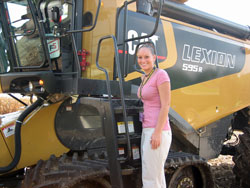 On Tuesday, the demonstrations were canceled due to all the rain but they started up yesterday in full force! I was able to see the combines harvest the corn; it was really nice to see the operation set up for the public to watch the demonstrations. All the combines all line up along the right side of the field and it is all roped off so people can watch them slowly. A combine runs about every 3-4 minutes so you are able to see each combine by itself.
On Tuesday, the demonstrations were canceled due to all the rain but they started up yesterday in full force! I was able to see the combines harvest the corn; it was really nice to see the operation set up for the public to watch the demonstrations. All the combines all line up along the right side of the field and it is all roped off so people can watch them slowly. A combine runs about every 3-4 minutes so you are able to see each combine by itself.
With the media pass I have, I was able to ride in one of the combines. Amazing, how nice the combines are in the inside; way nicer than most cars I’ve ridden in! There was a rider seat next to the driver I got to sit in so I got the chance to watch the computer controlling the combine and be up close with the operation.
I was able to ride in a CAT Lexion combine, and Jeff Gray was the driver. Jeff Gray works for Claas and has for many years. I was able to do a short interview with him about his job and what he does. Also, I have a short video of the process of the combine harvesting the corn.
If I could recommend anything here at the Farm Progress Show, I would go see the demonstrations. The tractors/combines are enormous! It is amazing to see how the style, functions, and over quality changes over time.
Listen to my interview with Jeff Gray here:  Jeff Gray (1 min. MP3)
Jeff Gray (1 min. MP3)
Here’s the video:  Harvesting Corn (2 min WMV)
Harvesting Corn (2 min WMV)
Coverage of the Farm Progress Show is sponsored by Monsanto: 
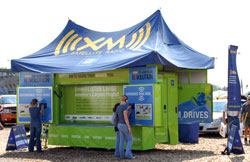 At the Chevrolet exhibit you’ll find XM Satellite Radio.
At the Chevrolet exhibit you’ll find XM Satellite Radio.

 With all the new technologies out, many of the people who come to the Farm Progress Show come to see the field demonstrations.
With all the new technologies out, many of the people who come to the Farm Progress Show come to see the field demonstrations.  On Tuesday, the demonstrations were canceled due to all the rain but they started up yesterday in full force! I was able to see the combines harvest the corn; it was really nice to see the operation set up for the public to watch the demonstrations. All the combines all line up along the right side of the field and it is all roped off so people can watch them slowly. A combine runs about every 3-4 minutes so you are able to see each combine by itself.
On Tuesday, the demonstrations were canceled due to all the rain but they started up yesterday in full force! I was able to see the combines harvest the corn; it was really nice to see the operation set up for the public to watch the demonstrations. All the combines all line up along the right side of the field and it is all roped off so people can watch them slowly. A combine runs about every 3-4 minutes so you are able to see each combine by itself.

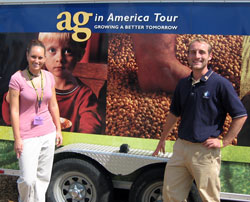 Ag in America Tour goes around to different schools across the Midwest promoting agriculture. It is up to the younger generation to determine how our future goes. They will be the ones filling our shoes later down the road.
Ag in America Tour goes around to different schools across the Midwest promoting agriculture. It is up to the younger generation to determine how our future goes. They will be the ones filling our shoes later down the road.  It’s a beautiful morning here on the final day of the Farm Progress Show.
It’s a beautiful morning here on the final day of the Farm Progress Show.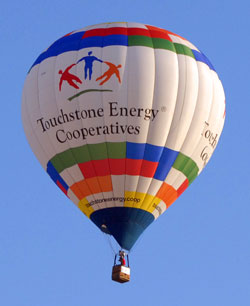 By the time we got to the media tent the balloon was almost on top of us.
By the time we got to the media tent the balloon was almost on top of us.  I had the chance to talk to Greg Webb, Vice President of Public Affairs. Greg was very knowledgeable about the direction ADM was heading. Technology is always changing and it is up to them to keep up with it!
I had the chance to talk to Greg Webb, Vice President of Public Affairs. Greg was very knowledgeable about the direction ADM was heading. Technology is always changing and it is up to them to keep up with it!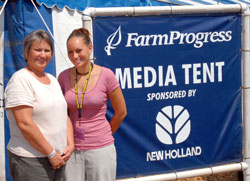 I know this whole Farm Progress Show thing isn’t my mom’s style but I know she enjoyed going around with me, looking for blogging opportunities. We walked around the whole grounds, went through the Varied Industries Tent and other various locations.
I know this whole Farm Progress Show thing isn’t my mom’s style but I know she enjoyed going around with me, looking for blogging opportunities. We walked around the whole grounds, went through the Varied Industries Tent and other various locations.  There are a few corn burning stove companies at the Farm Progress Show but the one I had a chance to glance at was
There are a few corn burning stove companies at the Farm Progress Show but the one I had a chance to glance at was 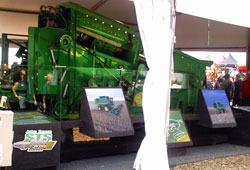 I finally had a chance to walk around a little today. One of the first exhibits I wandered through was
I finally had a chance to walk around a little today. One of the first exhibits I wandered through was 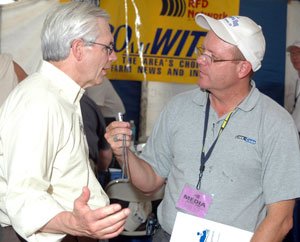 Our USDA Under Secretary for Rural Development, Thomas Dorr was on hand here at the Farm Progress Show.
Our USDA Under Secretary for Rural Development, Thomas Dorr was on hand here at the Farm Progress Show.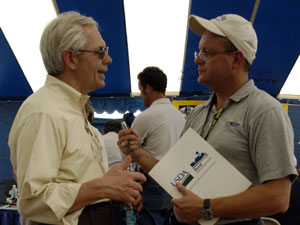 Both of them were shooting with Nikons, my personal favorite. I have my new Nikon D200 with me and I’m still learning how to use it.
Both of them were shooting with Nikons, my personal favorite. I have my new Nikon D200 with me and I’m still learning how to use it.